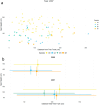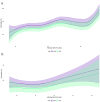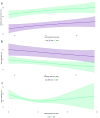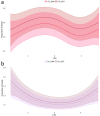Sky High or Grounded: Nest Site Selection of Herons and Egrets in a Mixed-Species Colony
- PMID: 39748809
- PMCID: PMC11693640
- DOI: 10.1002/ece3.70761
Sky High or Grounded: Nest Site Selection of Herons and Egrets in a Mixed-Species Colony
Abstract
Resource partitioning is crucial for the coexistence of colonial herons, as it allows multiple species to share the same habitat while minimising competition. This study took advantage of a natural experiment in 2006 and 2007 when Black-crowned Night Herons were prevented from breeding at Lake Fetzara in the first year due to the presence of a feral cat. This event provided valuable insight into the spatial and temporal dynamics of nest site selection among coexisting heron species, which consisted of Cattle Egrets (Ardea ibis), Little Egrets (Egretta garzetta) and Squacco Herons (Ardeola ralloides). After the cat was removed, egg-laying began in the core areas of the colony and gradually spread to the periphery. Species that initiated nesting early selected mid-elevation sites near the tree trunk, which likely offered protection from both ground and aerial predators, while also providing some shielding from solar radiation and strong winds. These early selected sites featured larger branches, which conferred greater nest stability. Vertical stratification was evident among the heron species; however, contrary to long-standing assumptions, it was not directly related to body size. Both vertical and horizontal stratification were observed, with nests progressively moving higher and further from the tree trunk as the breeding season advanced. The following year, Black-crowned Night Herons displaced other species to lower heights and positions further from the trunk, highlighting the significant influence of interspecific interactions on nest site selection. This study underscores the complex interplay between nest site selection, biotic interactions and abiotic factors in heron colonies, emphasising the importance of resource partitioning in maintaining species coexistence in densely populated breeding sites.
Keywords: Ardeidae; North Africa; breeding phenology; colonial Waterbirds; competition; resource partitioning.
© 2024 The Author(s). Ecology and Evolution published by John Wiley & Sons Ltd.
Conflict of interest statement
The authors declare no conflicts of interest.
Figures








Similar articles
-
Cattle egrets are less able to cope with light refraction than are other herons.Anim Behav. 1999 Mar;57(3):687-694. doi: 10.1006/anbe.1998.1002. Anim Behav. 1999. PMID: 10196060
-
Heavy metal and selenium levels in feathers of young egrets and herons from Hong Kong and Szechuan, China.Arch Environ Contam Toxicol. 1993 Sep;25(3):322-7. doi: 10.1007/BF00210724. Arch Environ Contam Toxicol. 1993. PMID: 8215588
-
Patterns of resource partitioning by nesting herons and ibis: how are odonata exploited?C R Biol. 2012 Apr;335(4):310-7. doi: 10.1016/j.crvi.2012.03.009. Epub 2012 Apr 24. C R Biol. 2012. PMID: 22578577
-
Egg recognition and chick discrimination in colonial breeding birds.Behav Processes. 2019 Nov;168:103955. doi: 10.1016/j.beproc.2019.103955. Epub 2019 Sep 4. Behav Processes. 2019. PMID: 31493492
-
Predators and the breeding bird: behavioral and reproductive flexibility under the risk of predation.Biol Rev Camb Philos Soc. 2009 Aug;84(3):485-513. doi: 10.1111/j.1469-185X.2009.00085.x. Biol Rev Camb Philos Soc. 2009. PMID: 19659887 Review.
References
-
- Alisauskas, R. T. 1987. “Morphometric Correlates of Age and Breeding Status in American Coots.” Auk 104: 640–646.
-
- Ando, Y. 1993. “Nest Site Selection of Six Heron Species in a Breeding Colony.” Japanese Journal of Ornithology 41: 29–38.
-
- Arévalo‐Ayala, D. J. 2022. “Within‐Colony Nest Distribution of a Waterbird Mixed Colony in a Small Alluvial Forest at El Salvador.” Neotropical Biodiversity 8: 76–88.
-
- Ashoori, A. , and Barati A.. 2013. “Breeding Success of Black‐Crowned Night Heron ( Nycticorax nycticorax ), little Egret ( Egretta garzetta ) and Cattle Egret ( Bubulcus ibis ) (Aves: Ardeidae) in Relation to Nest Height in the South Caspian Sea.” Italian Journal of Zoology 80: 149–154.
LinkOut - more resources
Full Text Sources
Miscellaneous

